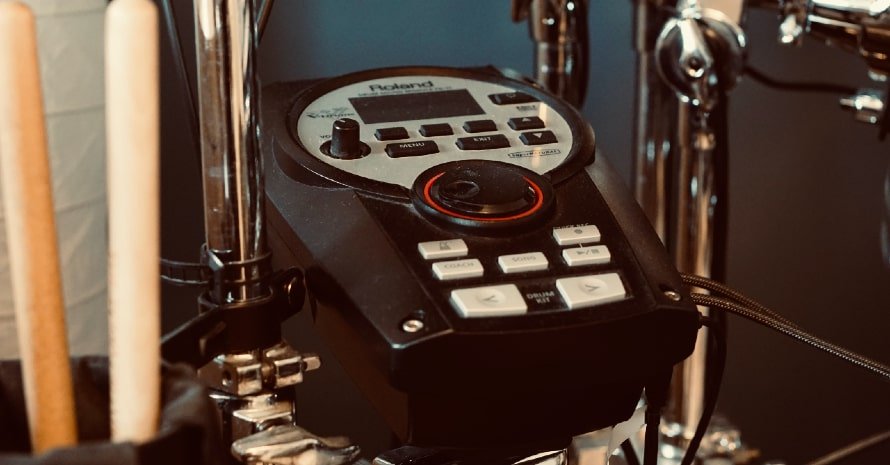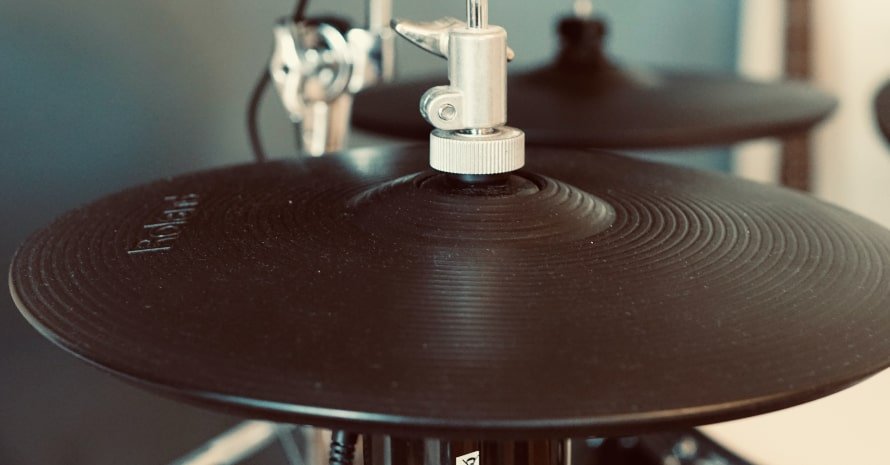
An electronic drum set is a musical instrument that imitates the sound of a regular drum by using electronic sensors to produce the sound.
There are many different types of electronic drums available on the market, from simple electronic drum kits that include a basic set of pads and a few sounds, to more advanced kits that include a wider range of pads, drums, and sounds.
Some electronic drums also include features such as a built-in metronome, recording capabilities, and the ability to connect to a computer for additional features.
What Does an Electric Drum Set Consist of?
Contents
The basic components of an electric drum kit are the pads, the brain, and the speakers. The pads are the actual drums that you hit, and they are connected to the brain.
The brain is the electronic module that creates the sound of the drums. The speakers are connected to the brain and amplify the sound.
Pads
The pads are the most important part of the kit, and there are a lot of different types to choose from. The most common type is the mesh head pad.
These pads have a mesh head that you hit with your sticks. They feel a lot like playing an acoustic drum, and they are very responsive.
Another popular type of pad is the rubber pad.
These pads are made of hard rubber, and they have a very bouncy feel. They are great for playing fast, aggressive music.
There are also electronic cymbals. These are just like regular acoustic cymbals, but they are mounted on an electronic pad. They are very responsive and realistic sounding.
Brain

The brain is the electronic module that creates the sound of the drums. It is also responsible for sending MIDI information to other devices, such as a computer. MIDI is a protocol that allows electronic instruments to communicate with each other.
The brain has a lot of different settings that you can adjust, such as the volume, the pitch, the attack, and the decay. You can also save your own presets, or use the presets that come with the brain.
Speakers
The speakers are connected to the brain and amplify the sound. They are usually powered by batteries or an AC adapter.
There are a lot of different types of speakers to choose from.
The most common type is the full-range speaker. These electronic drum kit speakers reproduce the full range of frequencies that the brain can create.
Another popular type of speaker is the subwoofer. These speakers reproduce the lower frequencies. They are great for adding extra bass to the sound.
Acoustic vs Electric Drums
If you’re a drummer, there’s a good chance you’ve at least considered making the switch to electronic drums. And it’s no wonder why. Electronic drums have come a long way in recent years, and offer several advantages over their acoustic counterparts.
For one, electronic drums are much more versatile. With the right setup, you can mimic just about any drum sound imaginable. And with the built-in effects and EQ controls, you can customize your sound to get it just the way you want it.
Another big advantage of electronic drums is that they’re much quieter than acoustic drums. This can be a huge plus if you live in an apartment or condo, or if you practice early in the morning or late at night. No more worrying about disturbing your neighbors!
Finally, electronic drums are generally more affordable than acoustic drums. You can get a great-sounding setup for a fraction of the cost of a comparable acoustic setup.
So if you’re thinking about making the switch to electronic drums, there’s no better time than now.
How Do Electric Drums Work?
Electric drums work by using sensors to detect the movement of the drumsticks and translate that into an electrical signal. This signal is then sent to an electronic drum module, which uses it to create the sound of a drum.
Most electric drums have two types of sensors: piezo sensors and pressure sensors. Piezo sensors are located under the drumhead and detect the vibration of the drumhead when it is hit.
Pressure sensors are located in the drum shell and detect the pressure of the drumstick when it hits the drum.
The electronic drum module contains a sound bank of drum sounds that can be selected.
It also has a built-in amplifier and speakers so that the drums can be played without an external sound system.
Electric drums have many advantages over acoustic drums. They are much quieter, so they can be used in places where acoustic drums would be too loud.
They are also more portable since they don’t need a separate sound system. And, since the sound is generated electronically, it can be customized to create any kind of drum sound.
How Do You Care for Electronic Drums?
Here are a few tips on how to care for your electronic drums:
1. Keep them clean
Just like any other musical instrument, your electronic drums will need to be kept clean. A build-up of dirt and grime can not only affect their appearance, but also their performance.
Use a soft, dry cloth to dust off your drums after each use. If they start to look dirty, you can clean them with a mild soap and water solution. Be sure to dry them thoroughly afterward.

2. Store them properly
When you’re not using your drums, it’s important to store them properly. If possible, keep them in a temperature-controlled environment.
Extreme temperature changes can damage your drums, so try to avoid storing them in a garage or shed. If you must store them in a less than ideal location, be sure to cover them to protect them from the elements.
3. Don’t use them in extreme weather
Just like with any other musical instrument, you should avoid using your electronic drums in extreme weather conditions.
Hot or cold temperatures can damage your drums, so it’s best to wait until the weather is more moderate before playing them. If you do need to use them in extreme weather, be sure to take measures to protect them from the elements.
4. Don’t drop them
Dropping your drums can damage them, so it’s important to handle them with care.
If you do accidentally drop them, be sure to inspect them for any damage. If you notice any cracks or other damage, it’s best to take them to a professional for repairs.
5. Don’t overload them
Just like with any other electrical device, it’s important not to overload your drums.
Only plug in as many devices as your drums can handle. If you try to plug in too many devices, it could damage your drums or cause them to malfunction.
6. Use them regularly
Using your drums regularly will help keep them in good condition.
If you don’t use them for long periods, the pads and other components can start to deteriorate. To avoid this, try to play your drums at least once a week.

FAQ
How do you choose the right electronic drums for your needs?
Beginner electronic drums usually have fewer features and are less expensive. Advanced electronic drum sets have more features and are more expensive. Professional electronic drum sets have the most features and are the most expensive.
How do you set up electronic drums?
The electronic drums should be set up so that the kick drum is on the left side and the snare drum is on the right side. The toms should be placed in between the kick drum and the snare drum. The cymbals should be placed on the outside of the toms.
Do electronic drum sets need special care?
Like any other musical instrument, your electronic drums need to be kept clean. Dirt buildup can affect not only their appearance but also their performance.
It is also important to store them properly. If possible, store them in a temperature-controlled area.
Conclusion
Electronic drums are an excellent choice for drummers who are looking for a portable and affordable option that still delivers a great sound quality. They are also perfect for beginner drummers who are looking to get their first taste of drumming.
Electronic drums are also a great option for drummers who have a limited amount of space, or for those who want to be able to take their drums with them on the road.

